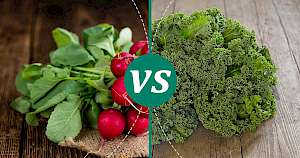Kale vs Radish: Nutrition, Calories & Protein Compared


Kale vs Radish
Nutrition Facts
Serving size:
change
5g10g15g20g30g40g50g60g80g100g120g140g160g180g200g220g250g300g350g400g450g500g600g700g800g900g1000g
1oz2oz3oz4oz5oz6oz7oz8oz10oz12oz15oz20oz25oz30oz35oz40oz50oz
Amount Per Serving:
Serving size:
change
5g10g15g20g30g40g50g60g80g100g120g140g160g180g200g220g250g300g350g400g450g500g600g700g800g900g1000g
1oz2oz3oz4oz5oz6oz7oz8oz10oz12oz15oz20oz25oz30oz35oz40oz50oz
Amount Per Serving:
Kale vs Radish 100g Compare
| per 100g | Kale | Radish |
|---|---|---|
| Calories | 49 | 16 |
| Carbohydrates | 8.75 g | 3.4 g |
| Fat | 0.93 g | 0.1 g |
| Dietary fiber | 3.6 g | 1.6 g |
| Protein | 4.28 g | 0.68 g |
| Calcium | 150 mg | 25 mg |
| Iron | 1.47 mg | 0.34 mg |
| Magnessium | 47 mg | 10 mg |
| Potassium | 491 mg | 233 mg |
| Sodium | 38 mg | 39 mg |
| Zink | 0.56 mg | 0.28 mg |
| Vitaminium A | 9990 µg | 7 µg |
| Vitaminium B2 (riboflavin) | 0.13 mg | 0.039 mg |
| Vitaminium B3 (Niacin) | 1 mg | 0.254 mg |
| Vitaminium B6 | 0.271 mg | 0.071 mg |
| Vitaminium B9 (Folic acid) | 141 mg | 25 mg |
| Vitaminium C | 120 mg | 14.8 mg |
| Vitaminium K | 704.8 µg | 1.3 µg |
Discovering the Nutritional Powerhouses: Kale and Radish
When it comes to enriching our diets with vibrant, nutrient-dense vegetables, kale and radish stand out for their unique benefits and flavors. Known for its dark, leafy greens, kale has been celebrated as a superfood, packed with vitamins and antioxidants. On the other hand, the crisp, peppery radish adds a refreshing bite to any dish. But beyond their taste and culinary uses, how do these vegetables compare nutritionally? Let's dive into the world of kale and radish to uncover their health benefits and decide which one might be the right choice for your diet.
Nutritional Content: A Closer Look
At first glance, both kale and radish offer a low-calorie option for those looking to maintain a healthy diet. With kale at 49 calories per 100 grams and radish at a mere 16 calories, both vegetables are excellent choices for weight management. However, the similarities don't end there. Both are virtually cholesterol-free, emphasizing their heart-healthy attributes.
When it comes to macronutrients, kale takes the lead with higher levels of protein, carbohydrates, and dietary fiber. Specifically, kale provides 4.28 grams of protein and 3.6 grams of fiber, making it a more satisfying choice for those looking to stay full longer. Radish, with 0.68 grams of protein and 1.6 grams of fiber, still offers a respectable amount of these essential nutrients but at a lower scale.
Vitamins and Minerals Galore
The real nutritional showdown begins when examining the vitamin and mineral content of these vegetables. Kale is an undeniable powerhouse, offering an impressive array of nutrients. It boasts a remarkable vitamin K content of 704.8 mcg, essential for blood clotting and bone health, and a high vitamin A content of 9990 IU, crucial for vision and immune function. Additionally, its calcium, iron, and magnesium levels far surpass those of radish, making kale an excellent choice for supporting bone health and energy levels.
Radish, while not as nutrient-dense as kale, still holds its own with a good supply of vitamin C, potassium, and zinc. These nutrients contribute to immune system health, blood pressure regulation, and wound healing. Moreover, the subtle amounts of iron and magnesium in radish can complement a well-rounded diet.
What About Taste and Versatility?
While nutrition is crucial, the taste and how these vegetables can be incorporated into meals also matter. Kale's robust flavor and hearty texture make it a versatile ingredient in smoothies, salads, and as a cooked green. Radish, with its crisp texture and peppery taste, is excellent raw in salads, pickled, or even roasted for a milder flavor.
Final Thoughts
Choosing between kale and radish depends on your nutritional needs, taste preferences, and how you like to enjoy your vegetables. For those seeking a nutrient powerhouse to support a healthy lifestyle, kale is an excellent choice. However, if you prefer a low-calorie, crunchy vegetable that adds a burst of flavor to your dishes, radish is a fantastic option. Ultimately, incorporating a variety of vegetables into your diet is the best way to ensure you're getting a broad spectrum of nutrients, so why not enjoy both kale and radish in your culinary creations?
Kale 100g
49kcalCalories source
- 58% CARBS.
- 28% PROTEIN
- 14% FAT
Radish 100g
16kcalCalories source
- 79% CARBS
- 16% PROTEIN
- 5% FAT
Compares of kale
- Kale vs Artichoke
- Kale vs Arugula
- Kale vs Asparagus
- Kale vs Beetroot
- Kale vs Bitter Melon
- Kale vs Bok Choy
- see all compares of kale
Compares of radish
Read also:
- Calories from Kale
- Calories of Kohlrabi
- Calories in Leek
- Lettuce calories per 100g
- Lima beans protein per 100g
- How many calories does lotus root have?
- Calories in a half of mustard greens leaves
- Calories in whole mustard greens leaves
- Calories for one, two or more mustard greens leaves
- Calories in handful of mustard greens leaves
- How much protein in okra?
Marcin Piotrowicz
calories-info.com creator
Healthy diet and healthy lifestyle promoter
Add comment